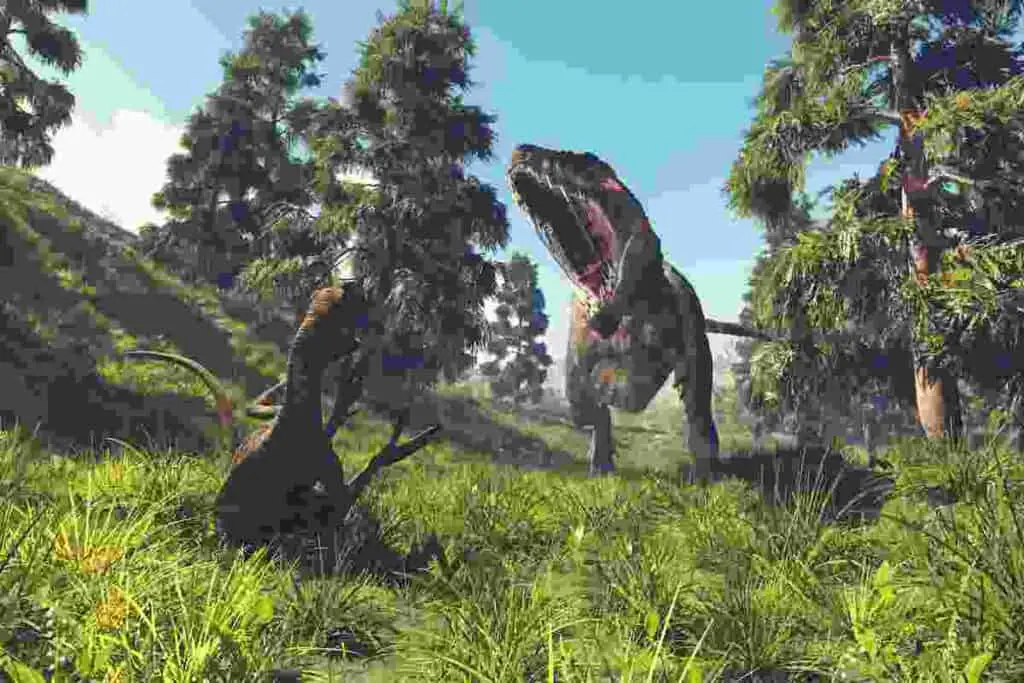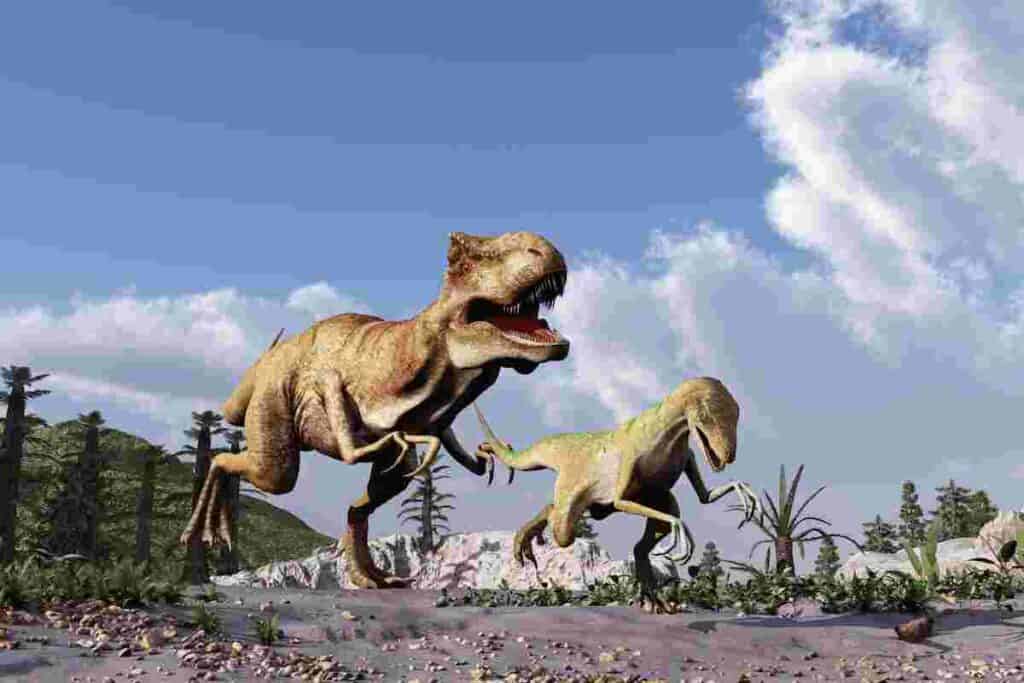Apex predators are the most feared in the animal kingdom for they dominate the trophic levels, which means that they can eat or get what they want. Tyrannosaurus rex is one of the known predators in the dinosaur world and probably one of the apex predators during its time attributed to its brute strength and body build suited for one.
Was Tyrannosaurus rex an apex predator? Yes, the T-Rex was an apex predator in its time. It does not have any natural enemies and may have died only due to injuries from fighting with other dinosaur species and other T-rex individuals.
You may already have an idea that T-Rex is indeed a ferocious dinosaur species, and you might be wondering how superior it is among the other dinosaurs. Like lions considered as the apex predators of the modern-day, this dinosaur might have been at the top of the food chain during its existence.
In this article, I have assembled some facts and evidence that might answer your query if T-Rex is undoubtedly the apex predator of its time. Also, the threats to the T-Rex and other apex predators that might have coexisted with it.
When Did The Tyrannosaurus Rule As The Apex Predator?
T-Rex’s existence has brought many changes in the Dinosaur world in terms of superiority and ecosystem balance. Here are some facts about when the T-Rex rules as an apex predator.
In the Life of An Apex Predator
Apex predators are situated at the top of the food chain where no animals will prey on them. They are found at the fourth to fifth trophic level in the ecosystem, where humans are their only enemy.

These highest predators are essential because they promote ecological stability, including populations of different species. By preying on the second predators down to the smaller predators, other species & prey will stay sustainable.
They are the ultimate natural predators serving as the controller of the overall population of the ecosystem. In ecology, a healthy ecosystem has beneficial apex predators that can dictate the population of bottom species making top predators crucial to species survival. (Source)
The T-Rex Rule: When and What It’s Like as an Apex Predator
One of the apex predators to ever walk the earth was the Tyrannosaurus Rex, “the king of the dinosaurs” or “the king of the tyrant lizards.” This dinosaur was the largest and the most ferocious apex predator of all time.
The T-Rex was a carnivorous dinosaur and a scavenger that also feeds on the dead bodies of other animals. One of its distinct features is the giant skulls that reach a colossal 1.52 meter or five feet in length. It also has a poisonous and the most substantial bite ever recorded in animals.
The T-Rex has a massive body with a weight of 5.5 to 8 tons or around 4900 to 7200 kilograms. It is 40 feet long and 12 feet tall which is about the size of a school bus. These fierce dinosaurs preyed on living animals using their sharp serrated teeth and powerful jaws that could crush a car. (Source)
During its time, T-Rex was one of the famous dinosaurs in North America in the forested river valleys in its western part, where they ruled as an apex predator. It has an estimated life expectancy of 28 years, but the T-Rex and the rest of the dinosaurs only existed during the late Cretaceous period, 68 million years ago. T-Rex was not an exception to the “mass extinction event” on the earth 66 million years ago. This event was due to the asteroid, which is the size of a mountain, crashing to the planet, wiping the majority of the life forms.
From the above, we can formulate rough criteria on what it takes to be the Apex Predator:
*The predator had to be a hunting dinosaur
*The dinosaur had to be considerably larger and stronger than its prey
*It had no enemies, ie no other dinosaur would hunt it
*It had to have features and characteristics that would give it an advantage ie sharper teeth, more intelligent, etc
If T-Rex Was the Apex Predator, Who Were the T-Rex’s Enemies?
Knowing that T-Rex is an apex predator, many species might have still challenged its superiority or compete with its resources. It has been proven by fossils discovered by paleontologists through time.
Natural Enemies of the T-Rex
The T-Rex was both an active hunter and a scavenger. It has a poisonous bite, sharp teeth, a powerful jaw, an arm that would clutch its prey, and feet that slash flesh. It also has a well-developed brain, particularly the optic nerve responsible for carrying necessary information related to hunting for foods, based upon the results of computerized tomography scans of the T-Rex’s fossilized skulls & brain. It also possesses a fantastic sense of smell for locating its target.
YouTube Video About The Top 10 Predatory Dinosaurs
With these characteristics, it was the most ferocious carnivorous dinosaur at the end of the Cretaceous period, with no natural enemies and predators that could counteract or dare to attack it. However, as the years went by, scientists found out that these ultimate badass dinosaurs may have an enemy of the same kind.
Evidence of Its Natural Injuries That May Have Led to Death
The only thing T-Rex feared was another T-Rex because they attacked one another based upon its fossilized evidence that shows scars and wounds on its bones. The spots observed followed a very similar pattern to a T-Rex bite.
The concrete evidence for this was the fossilized T-Rex’s bone collected from the United States and Canada and studied by Nicholas Longrich, a Paleontologist. He found out these tooth markings on its bones deep gouge can only be inflicted by another T-Rex individual.
From Hell Creek Formation near Jordan, paleontologists collected four bones also having “distinctive tooth damages.” This finding made scientists hypothesize that T-Rex might have killed one another or ate carcasses from their fallen own kind. (Source)
This study was based upon the 2010 research, but what we know about the T-Rex is constantly changing because scientists continue to figure out the life of the king of dinosaurs with the use of improved technologies.
❖ Read Now! The Ultimate Guide to Tyrannosaurus Rex
The main article in the series, it is packed with information all about the King of the Dinosaurs. it provides information about the first discovery, some of the latest fossil findings, and covers the anatomy of the dinosaur. Following this, it provides a look at the classification and phylogeny. The places, where T. Rex fossils have been found are described and a few of the key fossil skeletons are described. The master article also covers:
—Interesting facts you may not know about T. Rex
—Unanswered questions about the T. Rex
—Links to the Series Articles (17 in total!) which give deeper info on the dinosaur.
Apex Predator Dinosaurs List
Tyrannosaurus rex is not the only apex predator in dinosaur history. With the diverse dinosaur species over time, a few others are worthy of being included in the list of apex predators during their time on the planet.
Allosaurus: An Apex Predator Before T-Rex
According to the recent study discovered in eastern Utah, there were apex predator dinosaurs before the king of dinosaurs came in. This predator dinosaur is known as Allosaurus, one of the most famous carnivorous dinosaurs. It lived during the late Jurassic period, 150 to 155 million years ago.
Paleontologists found its fossilized evidence in North America and Europe. This dinosaur was the top predator of the Jurassic era, using its powerful jaws with two to four inches long and sharp serrated teeth.
Like T-Rex, Allosaurus walked with two powerful legs and had a massive body that weighed two to 5.5 tons depending upon the Allosaurus species. There are three identified species, namely Allosaurus fragilis, Allosaurus europaeus, and Allosaurus maximus.

Generally, they had a long skull that measured three feet, had a large body, had short arms, and had a size that reached up to 38 feet long and 16.5 feet tall. Unsurprisingly, based upon its visible features, the Allosaurus looks the same as the T-Rex. One of their differences is that the T-Rex was larger than the Allosaurus.
Scientists were able to excavate more than 150 found fossils of Allosaurus in the Western, United States specifically the Cleveland-Lloyd Quarry in Utah and the Garden Park Quarry in Colorado that gave them a good grasp of Allosaurus life.
Giganotosaurus: Larger Than T-Rex
Another apex predator is the Giganotosaurus, the greek work of ‘Giant Southern Lizard.’ It roamed around modern-day Argentina in South America during the late Cretaceous period, 99.6 to 97 million years ago. According to recent studies, it is believed to be slightly larger than Tyrannosaurus rex. Giganotosaurus was 40 to 43 feet long and weighed up to almost 14 tons or 12,700 kilograms.
Giganotosaurus was similar to Tyrannosaurus rex when it comes to its demeanor features. These were their large skulls, sharp serrated teeth, short arms having three-fingered clawed hands, and walking upright using two powerful legs. (Source)
Spinosaurus: The Biggest Carnivore That Existed
Spinosaurus, considered the biggest carnivorous dinosaur (even more giant than Giganotosaurus and Tyrannosaurus rex), was also an apex predator. This giant dinosaur lived during the Cretaceous period, about 112 million to 97 million years ago, located in the swamps of North Africa. There were two species of Spinosaurus named after the location of their fossils, namely Spinosaurus aegyptiacus (Egyptian spine lizard) and Spinosaurus maroccanus (Moroccan spine lizard).
Spinosaurus means a “spine lizard” that is best described for its extended spine protrusions on its back. One of its distinguishing features is this very long spine that grows on its back vertebrae, referred to as “sail.” Its spine can reach up to seven feet or 2.1 meters connected to the body by the skin. (Source)
With its spine, Spinosaurus was the first dinosaur that could swim and spent life in the water, according to a study in 2014. Scientists debated whether their sail or spine function for thermoregulation, ward off enemies, or spread it when looking for mates.
However, the latest study confirms that the sail of the Spinosaurus was well-suited for swimming based upon the newfound fossil from Morocco’s Zrigat site in the northwest corner of Africa.
Torvosaurus: A Predator With A Distinct Mouth
Another studied apex predator is Torvosaurus, a giant carnivorous dinosaur with a body length of 10 meters or 33 feet and had a massive weight of 4 to 5 tons comparable to a modern-day adult hippopotamus.
This dinosaur existed during the late Jurassic period, about 155 to 144 million years ago. Torvosaurus has two species, and these were the Torvosaurus gurneyi and Torvosaurus tonneri. Their distinguishing feature is the number of teeth in the upper jaw of T. tonneri, the size & shape of its mouth. Remnants of this giant dinosaur were found in North America and Portugal, where Paleontologists used it to study the life of Torvosaurus.
Conclusion
Apex predators may sound scary, for no one preys on them, but their existence plays a significant role in the environment. These animals, then, should not be removed from an ecosystem because every species depends on them. And, it’s nice how we get to study, animate, see and learn how an apex predator from the past lived their life.
It is incredible how paleontologists introduced and presented us the enormous apex predator dinosaurs from millions of years ago so that people of today will be able to glimpse the past. With this information, especially the king of dinosaurs, scientists will study how the environment from the past works.

